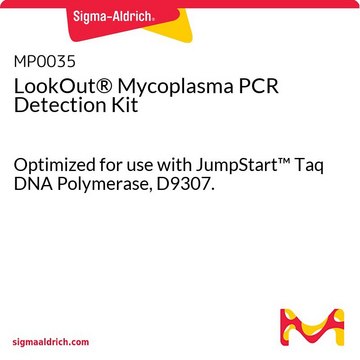MP0025
Venor™ GeM Mycoplasma Detection Kit, PCR-based
Synonym(e):
PCR mycoplasma detection kit
About This Item
Empfohlene Produkte
Verwendung
kit sufficient for 25 tests
Qualitätsniveau
Verpackung
pkg of 1 kit
Lagerbedingungen
dry at room temperature
Methode(n)
PCR: suitable
Anwendung(en)
detection
microbiology
Lagertemp.
2-8°C
Allgemeine Beschreibung
Anwendung
Komponenten
Lagerung und Haltbarkeit
Rechtliche Hinweise
Nur Kit-Komponenten
- Positive Control
- Negative Control
- PCR 10X Reaction Buffer 500 mL/vial
- Primer/Nucleotide Mix 1 mL/vial
Lagerklassenschlüssel
10 - Combustible liquids
WGK
WGK 3
Analysenzertifikate (COA)
Suchen Sie nach Analysenzertifikate (COA), indem Sie die Lot-/Chargennummer des Produkts eingeben. Lot- und Chargennummern sind auf dem Produktetikett hinter den Wörtern ‘Lot’ oder ‘Batch’ (Lot oder Charge) zu finden.
Besitzen Sie dieses Produkt bereits?
In der Dokumentenbibliothek finden Sie die Dokumentation zu den Produkten, die Sie kürzlich erworben haben.
Kunden haben sich ebenfalls angesehen
Artikel
Know when to use antibiotics to prevent contamination in cell culture and find related products at Sigma-Aldrich.com
Detect mycoplasma contamination in cell cultures three ways: culture test, DNA stain test, or mycoplasma PCR test. Mycoplasma elimination kits rid cultures of contamination.
Protokolle
Mycoplasma contamination of cell cultures is a serious issue impacting cell model validity. PCR testing for mycoplasma is an inexpensive, sensitive, and specific method for detecting contamination.
Unser Team von Wissenschaftlern verfügt über Erfahrung in allen Forschungsbereichen einschließlich Life Science, Materialwissenschaften, chemischer Synthese, Chromatographie, Analytik und vielen mehr..
Setzen Sie sich mit dem technischen Dienst in Verbindung.










